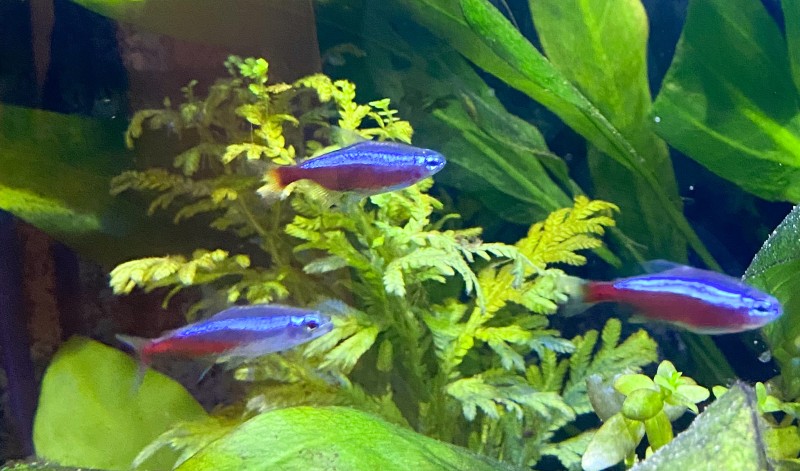I can’t imagine anything better than a tank full of Neon Tetra babies – but how can you tell if your neon is pregnant?
Technically, neons are egg-layers and don’t get ‘pregnant’, but let’s come onto terminology later. For now, let’s focus on the main signs of ‘pregnancy’.
What does a pregnant Neon Tetra look like?
To tell if your neon is expecting just from appearance, the only thing to really look for is whether the belly is bigger than the other females in your tank.
If you’re unsure of which of your Neon Tetras are male or female, jump back a step and learn how to check whether each neon is male or female. Females are:
- Larger than males, with shorter dorsal and anal fins
- More curvy than the slimmer males, including the neon line which appears curved as it contours over the bigger belly
- Less colorful

Once you’ve identified the females in the tank, you’ll be able to compare them side by side (good luck getting them to keep still long enough!) and if one has an enlarged belly, you may have yourself a pregnant neon.
Before I did my research, I wondered whether I had pregnant/gravid tetras, but that’s just because I didn’t know how to identify the sex of my neons. Once I realised females were a little more rounded naturally, I realised I was just looking at normal, healthy Neon Tetra ladies.
Pregnant Neon Tetra behavior
One key indicator of ‘pregnancy’ in neons is behavior, not only in the female concerned, but also the prospective father.
Courting patterns in Neon Tetras can be alarming at first. The rapid, odd patterns in their swimming looks like they may be unhappy with the water quality – but look closer.
If the male swims erratically, pausing and then resuming and especially swimming in square patterns, this is basically a neon’s way of impressing the female. He’s essentially dancing, to impress his potential mate, who crucially is carrying eggs.
If you’re interested in reading more about this fascinating mating ritual, tetra-fish-care.com have written up an excellent guide.
Gravid vs pregnant
Unlike other species such as Platys, Neon Tetras don’t give birth to live fry, which is where the distinction in terminology mentioned above becomes more important.
A female carrying eggs is ‘gravid’ whereas only live-birthing fish can really be said to be pregnant. So really this article should be titled ‘How can you tell if a Neon Tetra is gravid’ (but nobody really asks that question).

How to breed Neon Tetra in a tank
This is really hard to do. Firstly, neons eat their eggs, so you need to be fast. That’s if you can get them to breed in the first place – as I say, I’ve had tetras for a while now and never seen any signs of the females being gravid.
First, you’ll need a breeding tank with just the right water parameters:
- Low water hardness – ideally less than 3 dGH
- Slightly acidic pH – between 5 and 6 is perfect
- Temperature around 78°F/25°C
A basic starter tank like this one is fine as a breeding tank – don’t do things the lazy way and put a breeding box in your existing tank as you’ll need very specific conditions, such as lighting (see below).
You’ll need plenty of places for the new fry to hide – a covering of plants is ideal. They’re hiding from two things – firstly from being eaten as eggs or as fry, and secondly from the light. Neon Tetra fry are super sensitive to light during those first days, so having a nice shady area will give you the best chance of success.
A top tip is to attach blackout window film to the sides of the tank to limit the amount of light getting in. I recently used this to create a black background in my community tank and it looks great as well as being practical for breeding and raising Neon Tetra fry.

Stock the breeding tank with one or two pairs of male and female neons, then leave them for a couple of weeks.
Feed them live, protein-rich foods – live is far better but use frozen if you must. Protein is metabolized in the fish’s body and converted to energy to help them breed, produce and develop eggs, so the right food is crucial to the process.
Bloodworm and brine shrimp are ideal to really get their juices flowing (candles and soft music are optional).
Interested in more of the science? Check out this deep dive from thefishsite.com.
Turning the lights on after an extended period of darkness is the best way to encourage spawning behavior, but you may not witness this so remove the adults after two weeks and keep an eye on the tank.
Top tip: neons tend to spawn in the morning so if you want to see the magic for yourself, turn on the tank lights first thing, grab a coffee and keep an eye on your tank. It’s rare, but you may just catch them in the act.
How long do Neon Tetra eggs take to hatch?
Neon Tetra eggs take between 24 and 40 hours to hatch. Once you see small, round, white eggs sticking to your plants, chances are you’ll have fry within a day.
Around a third to half of the eggs will hatch if you’re lucky, but as the female neon can potentially release around 120 eggs in a successful spawn, you won’t be short of babies!

What to feed Neon Tetra fry
The newly-hatched fry will get all the nutrition they need from the egg sacs for the first 4-5 days. After this, start to add some food to the tank and make sure you use dedicated fry foods such as NorthFin’s powdered formula.
Care for your new arrivals properly and they’ll live around 5-6 years – find out more about how long Neon Tetras live and how to prolong their lifespan here.
Related Posts:
- There’s a great case study here describing a successful breeding process, using rainwater and leaf litter to provide shelter for the fry.
- Neon Tetra tank size guide
- Best schooling fish for aquariums
- Neon Tetra behavior guide
